Papers by Parakrama Wijekoon

JOURNAL OF MULTIDISCIPLINARY DENTAL RESEARCH, 2021
Objective of the study was to assess knowledge, attitude, and practices towards COVID-19 infectio... more Objective of the study was to assess knowledge, attitude, and practices towards COVID-19 infection of Sri Lankan dental undergraduates at the Faculty of Dental Sciences, University of Peradeniya, Sri Lanka. A descriptive cross-sectional study was conducted with participation of 246 undergraduate students in pre-clinical and clinical years in the Faculty of Dental Sciences, University of Peradeniya, Sri Lanka. A pretested, self-administered questionnaire sent via a Google form was used to collect data assessing above. Knowledge, practice, and fear scores of the students were assessed and compared considering their gender, age, year of study and socio-economic status. Students had a high knowledge score of 89.6%. Students had a good practice score of 84.4%. Clinical students had favorable practices to prevent spread than pre-clinical students (p=0.026). Mean for knowledge, practice and fear was higher among female students, but the difference was not statistically significant. Fear sc...
European Journal of Oral and Maxillofacial Surgery, 2022

Background: We designed this prospective observational study in order to evaluate whether convent... more Background: We designed this prospective observational study in order to evaluate whether conventional predictors of “Difficult airway” truly predict difficult airway in patients who present for cleft surgeries at Cleft Centre Peradeniya. Methods: One hundred and two babies between the ages of 2 months to 18 months who underwent cleft lip or palate repairs at Cleft centre, Peradeniya August 2015 to April 2016 were included in the study. For each of the patients, we gave a grade for the degree of mouth opening and the laryngoscopic view prior to surgery. Results: Out of the 102 participants, 9.8% of patients had difficult laryngoscopy. At least one out of seventeen studied “predictors of difficult airway,” was found in seven patients out of the 10 in whom laryngoscopy was difficult. There was a significant association of difficult laryngoscopy with reduced mouth opening. Furthermore, factors such as the presence of microstomia, micrognathia, retrognathia, and short neck were signific...

Background Post-operative pain relief in cleft surgery should be efficient and effective. The Fac... more Background Post-operative pain relief in cleft surgery should be efficient and effective. The Face, Leg, Activity, Cry and Consolability (FLACC) scale is a validated tool for post-operative pain assessment in patients who cannot express themselves verbally. The objective of this study was to assess the effectiveness of the analgesic protocol practiced at the Dental Hospital Peradeniya, using FLACC scale during the first 24 hours following cleft surgery. Methods and material Sample included 193 patients who underwent primary repair of cleft lip and palate. They were given paracetamol two hours before surgery and 0.1mg/kg intravenous morphine during surgery. Infra-orbital nerve blocks for cleft lip surgeries, greater palatine nerve blocks for cleft palate surgeries and rectal diclofenac suppository (1.5 mg/kg) if above six months of age were added. The surgical site was infiltrated with 1% lignocaine in adrenaline. Oral paracetamol was used post-operatively. Cuddling, carrying, lullab...
Sri Lanka Journal of Child Health, 2022
European Journal of Oral and Maxillofacial Surgery
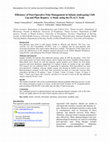
Background Post-operative pain relief in cleft surgery should be efficient and effective. The Fac... more Background Post-operative pain relief in cleft surgery should be efficient and effective. The Face, Leg, Activity, Cry and Consolability (FLACC) scale is a validated tool for post-operative pain assessment in patients who cannot express themselves verbally. The objective of this study was to assess the effectiveness of the analgesic protocol practiced at the Dental Hospital Peradeniya, using FLACC scale during the first 24 hours following cleft surgery. Methods and material Sample included 193 patients who underwent primary repair of cleft lip and palate. They were given paracetamol two hours before surgery and 0.1mg/kg intravenous morphine during surgery. Infra-orbital nerve blocks for cleft lip surgeries, greater palatine nerve blocks for cleft palate surgeries and rectal diclofenac suppository (1.5 mg/kg) if above six months of age were added. The surgical site was infiltrated with 1% lignocaine in adrenaline. Oral paracetamol was used post-operatively. Cuddling, carrying, lullab...

Journal of Patient Experience, 2021
We assessed perceived satisfaction of patients and related factors for treatment provided by the ... more We assessed perceived satisfaction of patients and related factors for treatment provided by the oral surgery student dental clinic of the only Sri Lankan dental school. A descriptive cross-sectional study was conducted among 288 consenting patients who received oral surgery treatment at the student dental clinic of Department of Oral and Maxillofacial Surgery, Faculty of Dental Sciences, University of Peradeniya, Sri Lanka. A self-administered, validated questionnaire and a 19-item multidimensional patient satisfaction scale were used for data collection. Patients of all ages were represented, but were dominated by females, aged 30 to 44 years, possessing educational attainment up to General Certificate of Education ordinary or advanced level of which 54.9% were unemployed. They had travelled distances of less than 10 and 10 to 20 km (28.1% and 27.5%, respectively) predominantly to receive tooth extractions exacerbated by symptoms. Overall, 90% of responding patients were highly sa...

Objective: To assess the perception and the performance of dental students on clinical component ... more Objective: To assess the perception and the performance of dental students on clinical component of the final year examination held during COVID-19 pandemic. Methods: Final year dental undergraduates (n=86) in year 2014 participated in the study. A pre tested, self-administered questionnaire (online Google form) was used to assess their preparedness and perception regarding changed clinical set up. Percentage marks obtained for each component was used to assess their performance during pre COVID and COVID times. Results: The mean scores for knowledge, attitude and fear were 82%, 94% and 77% respectively. There was no significance in the perception regarding the clinical set up for prosthetic dentistry (p= 0.317) and restorative dentistry (p=0.384) when pre and during COVID-19 groups were compared. However, a statistically significant difference was observed for oral surgery component (p=0.005) for the same. There was no significant correlation between the perception scores and the s...
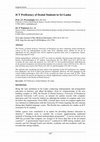
Sri Lanka Journal of Bio-Medical Informatics, 2012
The Faculty of Dental Sciences, University of Peradeniya has been conducting formal introductory ... more The Faculty of Dental Sciences, University of Peradeniya has been conducting formal introductory courses in ICT for undergraduates at their entry level. Although senior students do not get an opportunity for ICT education they will be required to perform tasks such as assignments, reports, referencing using ICT tools. Dental undergraduates' proficiency in ICT was tested on randomly selected groups from three senior batches. Total performance of all students tested showed that the MCQ score (53.4, SD 8.0) has exceeded the pass mark and practical test (44.0, SD 7.2) has recorded well below. Individual tests on the practical components also showed that students were extremely weak in M S Excel (8.1, SD 2.2) and well below pass mark in M S Word (16.9, SD 2.9) and Powerpoint (19.0, SD 5.3) tasks. This indicates that considering the basic nature of the questions in this ICT proficiency test, students have displayed a low level of skill in the practical component. However, the total aggregate for the overall student performance (48.8, SD 5.4) has recorded just below the pass mark of 50%. These results reiterate the need for development of a formal supplementary training course in ICT for students in senior batches in the Faculty of Dental Sciences.
Mars/Management of Cleft Lip and Palate in the Developing World, 2008
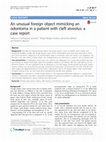
Journal of Medical Case Reports
Background: The habit of inserting foreign objects into body cavities is seen in children and in ... more Background: The habit of inserting foreign objects into body cavities is seen in children and in adults with intellectual disability. Usually, the foreign objects cause chronic inflammation and local tissue destruction, which give rise to symptoms. Diagnosis at an asymptomatic stage is uncommon when the history is not suggestive. We describe a rare case where a foreign object was misdiagnosed as an odontoma in a patient with an alveolar cleft. Case presentation: A radiopaque round mass was noted on the radiograph of a 12-year-old Sinhalese boy who was awaiting an alveolar bone graft. Apart from problems related to the alveolar cleft and mild halitosis, he was otherwise healthy. This was suspected to be an odontoma in the cleft region. During alveolar bone graft surgery, a button battery was recovered that was later confirmed as having been self-inserted by the child. Alveolar bone graft surgery was delayed because of local chronic inflammation due to the foreign object. Three months later, complete healing of the site was noted when reexplored for alveolar bone grafting. Conclusions: It is important to include foreign objects in the radiological differential diagnosis in asymptomatic children. Furthermore, cone beam computed tomography should be considered in suspected cases. Early removal with thorough debridement causes minimal tissue destruction.
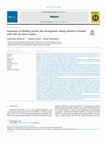
Heliyon
Background: Awareness of feeding among mothers plays an important role in the growth and developm... more Background: Awareness of feeding among mothers plays an important role in the growth and development of children with cleft lip and palate. Mothers' increased awareness provides the right care and nutrition to these children in order to grow and achieve their developmental milestones. Objectives: This study aimed at (1) assessing mothers' awareness on breastfeeding and formula-milk feeding, weaning, growth, and development of infants with cleft lip and palate and (2) the relationship of mothers' awareness with their level of education and monthly household income. Methods: This cross-sectional pilot study included all the mothers of infants aged up to one year who had cleft lip and/or palate attended Dental Teaching Hospital, Peradeniya between the years 2015 and 2016. Mothers of infants with oral clefts associated with other syndromic features and chronic illnesses were excluded. A pre-tested interviewer-administered questionnaire was designed to collect data. To assess the clarity of the questions, prior to the study, the questionnaire was pre-tested in 10 mothers of infants with an oral cleft but not selected for the study. Frequency distributions and descriptive statistics were used to describe study variables. Spearman Rank test was used to determine the association of mothers' awareness with their level of education and monthly household income with a 95% confidence interval. Results: The sample consisted of 101 mothers who had infants born with a cleft and the response rate was 100%. Except one, all mothers reported that they have received overall feeding instructions either from a doctor, nurse, cleft center staff or a midwife. Over 65.3% of mothers were aware of feeding-related factors including; breastfeeding, formula-milk feeding, and weaning of infants with a cleft. Overall more than 80% of mothers were aware of factors related to growth and development of the child including urination, sleeping pattern, weight and growth charts. The education level of mothers was not significantly associated with mothers' awareness of any factors related to breastfeeding, formula-milk feeding, weaning and growth, and development. Further, mothers' awareness of breastmilk as the best food for babies under 6 months (p ¼ 0.028), weaning at 4-6 months (p ¼ 0.024), replacing milk feeds by weaning foods (p ¼ 0.02) and not providing junk foods to infants in between main meals (p ¼ 0.01) were significantly associated with monthly household income. Conclusions: The findings of this study suggest that mothers were aware of factors related to feeding infants with a cleft lip and palate and their growth and development. The awareness of mothers about certain factors related to feeding and weaning was significantly associated with monthly household income.
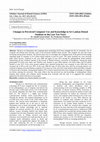
Advances in information and communication technology (ICT) have changed the life of everybody. Us... more Advances in information and communication technology (ICT) have changed the life of everybody. Use of computer and internet have become a part of the university student's daily activity. The computer use may have been increasing among dental students. The present study aims to investigate the changing trends of the perceived knowledge regarding usage of computer in Sri Lankan dental students in past ten years. This study included two cross sectional paper based surveys conducted in the year 2006 and again in year 2015 among the undergraduate dental students representing all four academic batches in the Faculty of Dental Sciences, University of Peradeniya. Among the study participants 95 (55%) were males and 76(45%) were females in year 2006 whereas 119 (34%) males and 229 (66%) females in year 2015. Forty seven present students have reported having their own computer in year 2006 and it has increased up to 92% in the year 2015. In the year 2006 the type of device they have used for accessing internet was confined to laptops (2%) and desktop computers (7%) where as in the year 2015 smart phones (24%) and tablet computer (13%) have been included. Among dental students 67% of them reported that they have adequate knowledge of computer use before entering the university. This study reflects that the perceived use and knowledge of undergraduate dental students about internet and computer based learning have increased with the time. It is suggested that computer application for dental education is encouraged.

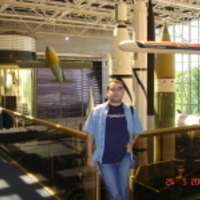






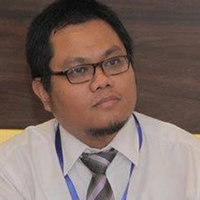


Uploads
Papers by Parakrama Wijekoon